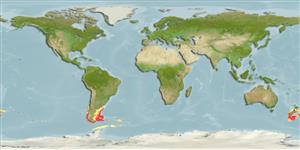Actinopterigi (pesci con pinne raggiate) >
Gadiformes (Cods) >
Gadidae (Cods and haddocks)
Etymology: Micromesistius: Greek, mikros = small + greek, mesos = middle + Greek, istion = sail (Ref. 45335). More on author: Norman.
Ambiente / Clima / Range
Ecologia
; marino benthopelagico; oceanodromo (Ref. 51243); distribuzione batimetrica 50 - 900 m (Ref. 27363), usually 200 - 400 m (Ref. 7061). Temperate, preferred 9°C (Ref. 107945); 37°S - 65°S, 165°E - 34°W (Ref. 54589)
There are 2 disjunct populations. Micromesistius australis australis occurs around the Falkland Islands and Argentine Patagonia in the southwest Atlantic; off Chile in the southeast Pacific; also off South Georgia, South Shetland and South Orkney islands. Micromesistius australis pallidus occurs around the South Island of New Zealand.
Length at first maturity / Size / Peso / Age
Maturity: Lm ?, range 33 - 40 cm
Max length : 90.0 cm TL maschio/sesso non determinato; (Ref. 1371); common length : 60.0 cm TL maschio/sesso non determinato; (Ref. 1371); Peso massimo pubblicato: 850.00 g (Ref. 4883)
Spine dorsali (totale): 0; Raggi dorsali molli (totale): 43-55; Spine anali 0; Raggi anali molli: 56 - 71; Vertebre: 54 - 57
Invades shelf waters during summer and concentrating over the continental slope in winter. Forms schools (Ref. 9072). The young feed on euphausiids and amphipods and occasionally on copepods, cephalopods and small fish. Utilized in frozen blocks and as fishmeal. In Japan used as suerii (minced meat) for karaoke (fish cake) (Ref. 27363). Can be fried, microwaved and baked (Ref. 9988).
Life cycle and mating behavior
Maturità | Riproduzione | Deposizione | Uova | Fecundity | Larve
Oviparous, sexes are separate (Ref. 205).
Cohen, D.M., T. Inada, T. Iwamoto and N. Scialabba, 1990. FAO species catalogue. Vol. 10. Gadiform fishes of the world (Order Gadiformes). An annotated and illustrated catalogue of cods, hakes, grenadiers and other gadiform fishes known to date. FAO Fish. Synop. 125(10). Rome: FAO. 442 p. (Ref. 1371)
IUCN Red List Status (Ref. 115185)
CITES (Ref. 94142)
Not Evaluated
Threat to humans
Harmless
Human uses
Pesca: elevato interesse commerciale
Strumenti
Special reports
Download XML
Fonti Internet
